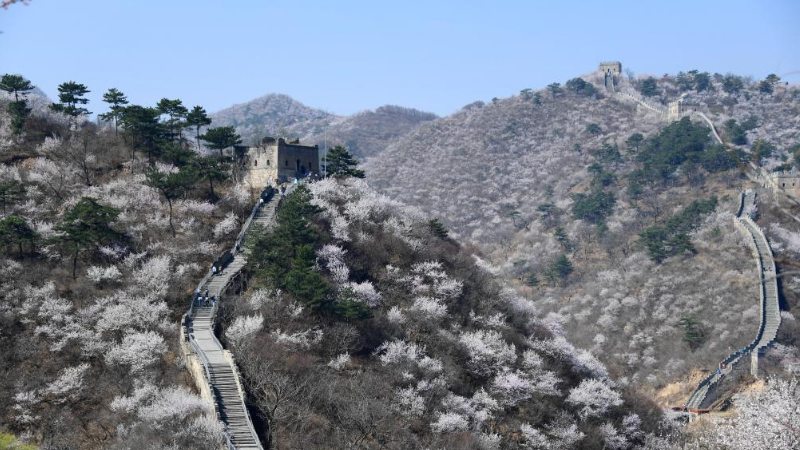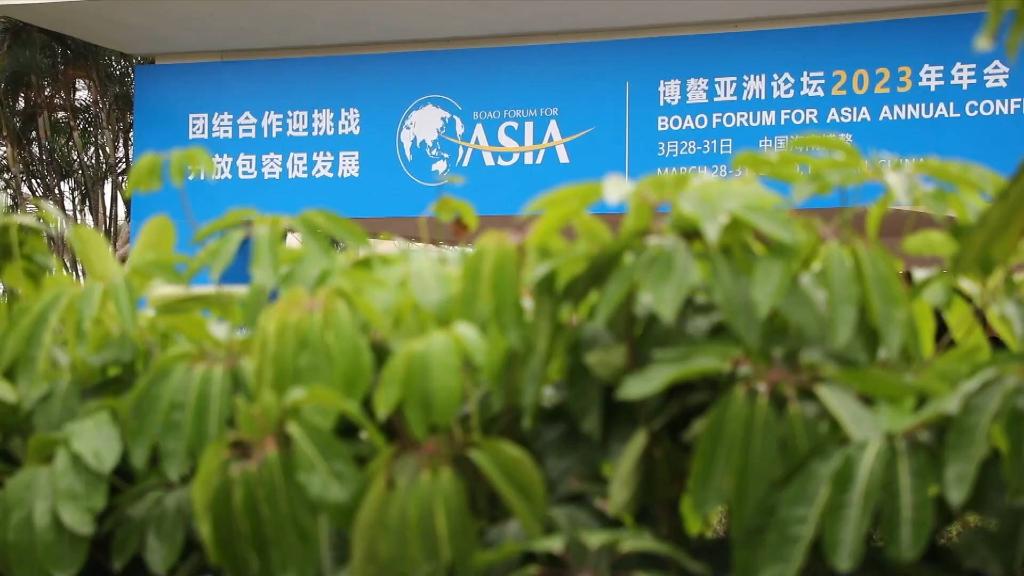* This year, the weighted real GDP growth rate of Asia is estimated at 4.5 percent, an increase from 4.2 percent in 2022, according to a report released Tuesday by the Boao Forum for Asia (BFA).
* Since the beginning of this year, more Asian countries have perceived China's renewed economic vigor and its ensuing driving force to regional recovery.
* China, a champion of multilateralism, is committed to sharing its development dividends with all partners, both regional and global, by offering global public goods.
by Xinhua writer Ma Qian
BOAO, Hainan, March 31 (Xinhua) -- As the Philippines started shipping fresh durians to China this month, 29-year-old Jomar Abdon, a Filipino durian grower, called access to the enormous Chinese market a bonanza.
Thanks to the deal signed during Philippine President Ferdinand Romualdez Marcos' visit to Beijing in early January, around 9,696 direct jobs and 1,126 indirect jobs will be generated after Philippine durians are cleared to export to China, according to the Philippine Department of Agriculture.
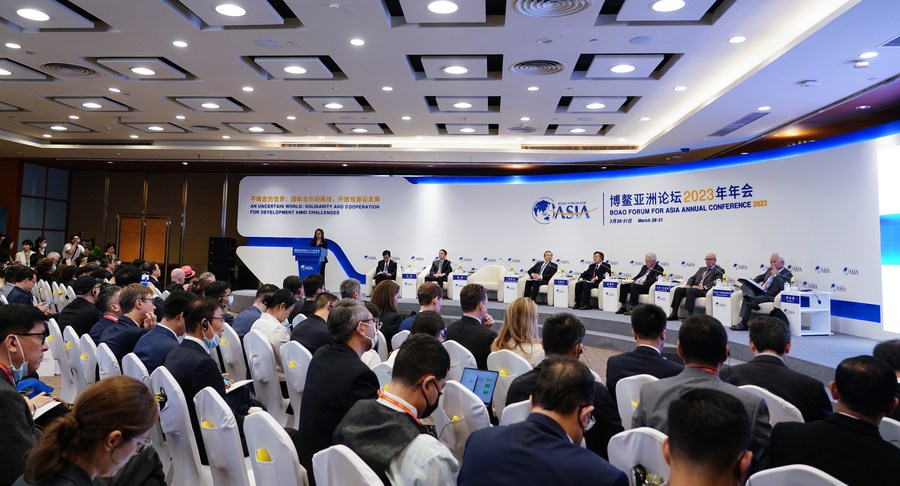
This photo taken on March 30, 2023 shows the venue of a session themed on "Building an Order of Cooperation and Security in the South China Sea" during the Boao Forum for Asia (BFA) Annual Conference 2023 in Boao, south China's Hainan Province. (Xinhua/Fan Yuqing)
This is one latest epitome of the vibrant Asian economic recovery after China optimized its epidemic prevention and control measures. This year, the weighted real GDP growth rate of Asia is estimated at 4.5 percent, an increase from 4.2 percent in 2022, according to a report released Tuesday by the Boao Forum for Asia (BFA) during its annual conference scheduled for March 28-31 in Boao, a coastal town in China's island province of Hainan.
In particular, a 1-percentage-point increase in China's GDP growth leads to a 0.3-percentage-point increase in growth in other Asian economies, said the report titled "Asian Economic Outlook and Integration Progress," citing data from the International Monetary Fund.
China's robust economic rebound has delivered very positive signals to not only Asia, but also the wider world, providing valuable certainty for a world afflicted with uncertainties, said BFA Secretary General Li Baodong during the forum.
China has served as a stabilizer for the economic growth of both Asia and the world, thanks to its high-quality development, cooperation-oriented policy measures and high-standard opening up, which also led to its rapid recovery, Zhang Yuyan, director general of the Institute of World Economics and Politics of the Chinese Academy of Social Sciences (CASS), told a press conference following the release of the report.
WEIGHTIER ASIAN GROWTH
Hailing Asia "a bright spot in the bleak global economic landscape," the report highlights that global economic governance enters into the "Asian moment," and regional economic integration has been advancing with trade dependence between regional economies standing at a relatively high level.
Since the beginning of this year, more Asian countries have perceived China's renewed economic vigor and its ensuing driving force to regional recovery. With strong trade and cooperation linkages with regional countries, China's high-quality development is widely expected to bring about a larger share of Asia's growth in 2023.
The status of the Association of Southeast Asian Nations (ASEAN) and China as hubs for trade in goods remained unchanged, said the report. The highest level of dependence was found among ASEAN members, reaching 21 percent in 2021. Japan and South Korea had a dependence on China of over 20 percent.
China-ASEAN cooperation has made Asia the most dynamic region in the world, said Kin Phea, director general of the International Relations Institute of Cambodia, an arm of the Royal Academy of Cambodia.
He noted that China's high-quality development will inject new impetus into ASEAN's economic development in the post-epidemic era, through bringing high-quality, more environmentally friendly and innovative investment projects, as well as the latest technologies to ASEAN, which will contribute to the building of a closer China-ASEAN community with a shared future.
Besides, China's resumption of outbound tourism is also expected to strongly stimulate the recovery of tourism and investment across Asia.
Since this year, a large number of Chinese tourists, especially business groups, have come to Laos to explore investment and trade opportunities. Later, a large number of agricultural, forestry, industrial and mining projects, with planned investment of over 100 million U.S. dollars, have taken shape in Laos targeting the Chinese market, according to Orlathy Santikhongkha, vice president of the Young Entrepreneur Association of Laos.

Chinese tourists visit the Grand Palace scenic spot in Bangkok, Thailand, Feb. 7, 2023. (Xinhua/Wang Teng)
The expert said that cross-border passenger trains are scheduled to launch on the China-Laos railway this year, further boosting the free flow of people, materials and capital between the two countries, and bringing much-needed vitality to regional growth.
DELIVERING GLOBAL PUBLIC GOODS
With the steady growth of its own economy, China, a champion of multilateralism, is committed to sharing its development dividends with all partners, both regional and global, by offering global public goods.
This year marks the 10th anniversary of the China-proposed Belt and Road Initiative (BRI), one of the country's flagship public goods designed to enrich the mechanism and content of international cooperation, as well as promote common prosperity for all.
Over the last decade, China has been dedicated to delivering public goods to the international community, including the Global Development Initiative (GDI), the Global Security Initiative (GSI), the Global Civilization Initiative (GCI) and the Asian Infrastructure Investment Bank, which are widely recognized as the country's unremitting efforts to advance Asian integration and globalization.
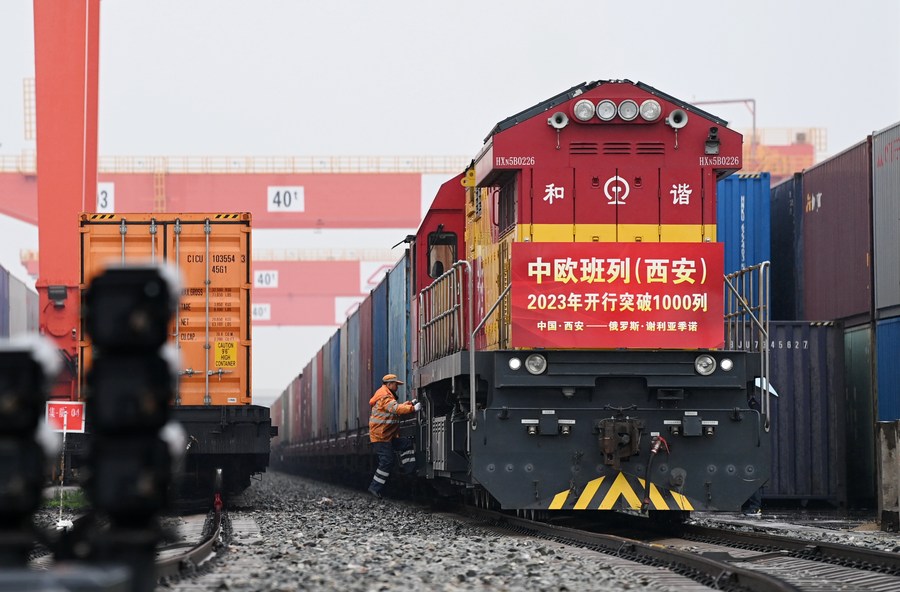
A China-Europe freight train is pictured at Xi'an International Port in Xi'an, northwest China's Shaanxi Province, March 23, 2023. (Xinhua/Li Yibo)
"China's series of initiatives based in Asia basically promote deeper economic integration, including improving policy coherence, promoting an enhanced cooperation platform and stronger collaboration. I think this is a welcomed development," said Allan Gepty, assistant secretary of the Philippine Department of Trade and Industry.
By improving infrastructure construction, promoting connectivity, and strengthening people-to-people and cultural exchanges, the BRI has not only promoted rules-based free trade system, but also made Asia a more prosperous region, he stressed.
Over the past decade, China has signed cooperation agreements with 151 countries and 32 international organizations, with its trade with countries along the Belt and Road up 19.4 percent in 2022 over the previous year.
The BRI paints a vision of connectivity and shows foresight, said Renat Bekturov, governor of Astana International Financial Center, during a sub-forum at the BFA on Tuesday.
Over the past decade, from ports to railways, a series of projects have built corridors in Europe and Asia, making the flow of people and goods between East and West unimpeded and making that vision a reality, he added.
For Ahsan Iqbal Chaudhary, minister for planning, development and special initiatives of Pakistan, the essence of the BRI lies in sharing.
He stressed that China is ready to share its successful experience in poverty alleviation with countries along the route without reservations or strings attached, so as to build a community with a shared future for mankind through promoting common prosperity.
The global public goods provided by China adhere to real multilateralism, which conforms to the trend of the times by upholding peaceful development and win-win cooperation, Xu Xiujun, research fellow with the Institute of World Economics and Politics at the CASS, told Xinhua.
Besides, China's public goods are completely open, not only to developing countries, but also to all developed countries. It is not exclusive, he said, adding Belt and Road cooperation enjoys a very strong continuity, and has entered a stage of high-quality development.
Phea from Cambodia pointed out that such global public goods as the BRI and the GDI are vital for practicing the concept of building a community with a shared future for mankind.
That means "China has played and will continue to play a vital role in promoting free trade, multilateralism and globalization, which are essential to building a just, equitable, open and inclusive world," he noted.
GREATER OPENNESS
As China has been pursuing a proactive strategy of opening up, its global public goods have been welcomed by the international community.
Moreover, as a major trading partner for more than 140 countries and regions, China has worked to build a globally-oriented network of high-standard free trade areas and accelerated the development of pilot free trade zones and the Hainan Free Trade Port, leading the world in total volume of trade in goods. It is also a major destination for global investment and a leading country in outbound investment.
"With a foreign policy that places peace and development at the core of its international engagements, China has demonstrated willingness to share the outcomes of its development with the rest of the world, in an effort to achieve global development targets such as those codified under the United Nations Sustainable Development Goals," said Cavince Adhere, a Kenya-based international relations scholar.
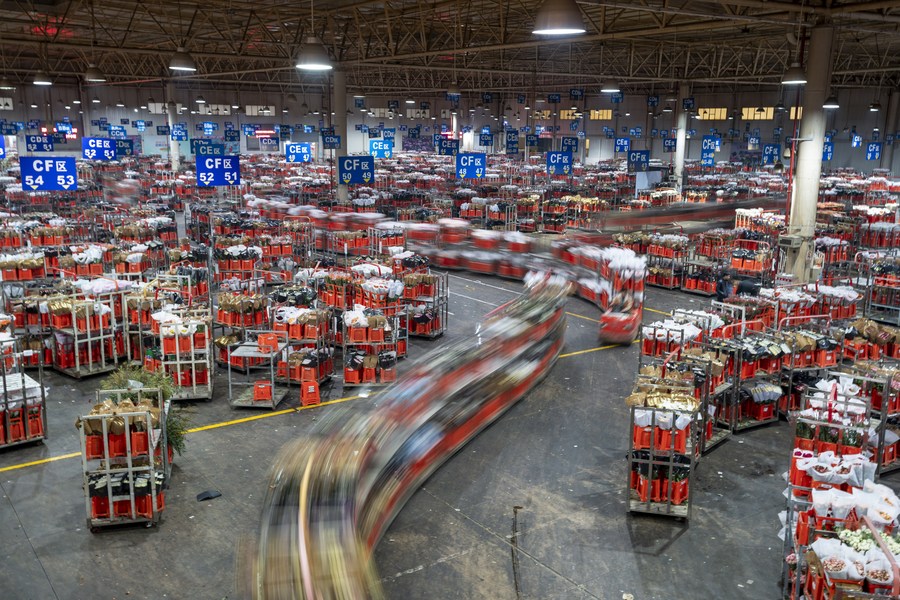
Workers transfer trolleys of flowers at the Kunming International Flora Auction Trading Center in Dounan, southwest China's Yunnan Province, Jan. 31, 2023. (Xinhua/Chen Xinbo)
Adhere said that the Regional Comprehensive Economic Partnership Agreement (RCEP), the world's largest free trade deal taking effect since January 2022, has not only benefitted member states, but also serves as an important benchmark for other regions seeking to consolidate economic integration.
The emergence of the RCEP provides reference for the world in building free trade agreements with higher level, wider scope and unified rules in the future, said Masahiro Morinaga, chief delegate of the Japan External Trade Organization's Chengdu office.
In this aspect, Santikhongkha from Laos observed that the RCEP has offered an open and fair platform for calibrating regional and global trade rules and order, and more importantly, giving participating countries a chance to find new cooperation breakthroughs on this platform.
It has prompted contemplations on how to make the best use of free trade mechanisms like the RCEP, which will be conducive to the upgrading of related policy measures and further benefitting more markets around the world, said the expert.
"Asia is home to two of the world's leading trade agreements, the RCEP as well as the CPTPP (Comprehensive and Progressive Agreement for Trans-Pacific Partnership), which really underscores the fact the region's committed to globalization, committed to trade as a driver of growth," said Ben Simpfendorfer, a partner at leading international management consulting firm Oliver Wyman, adding it "will ultimately be positive for global growth."
(Video reporters: Hong Liang, Wang Junfeng, Zhou Xuan, Guo Liangchuan, Li Duojiang, Yin Jiajie, Li Xiaohui, Li Yaguang; video editors: Yu Jiaming, Yin Le, Hui Peipei, Wang Han)■




